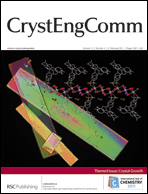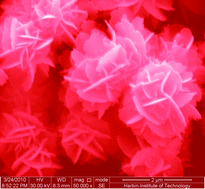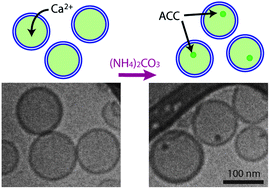
The authors have also observed ACC nanoparticles of up to
200 nm in liposomes extruded through a 1 mm pore size membrane. Showing no sign of faceting or crystallization, these are the largest ACC nanoparticles stabilized by confinement thus far.
The liposomal encapsulation strategies in combination with in situ imaging, scattering, and spectroscopy will aid in characterizing subsequent phase transformations and polymorph selection in the
nucleation and growth not only of calcium carbonate, but also other (bio)-minerals, pharmaceuticals, and proteins.
Read more for FREE at:
In vitro synthesis and stabilization of amorphous calcium carbonate (ACC) nanoparticles within liposomes
Chantel C. Tester, Ryan E. Brock, Ching-Hsuan Wu, Minna R. Krejci, Steven Weigand and Derk Joester
CrystEngComm, 2011, Advance Article
DOI: 10.1039/C1CE05153A











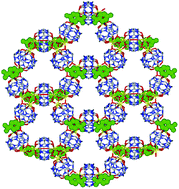 MOF have been much studied due to their potential applications from their excellent physical and chemical properties, however, many are unlikely to realize their potential due to the expense of the starting materials and/or complexity of the synthesis involved. In this HOT article, Day and co-workers have formed stable cucurbit[5]uril MOF structures as ‘beaded’ rings built on a p-hydroxybenzoic acid template prepared readily by self-assembly as a supramolecular structure that remarkably can be recrystallised from water to form the same stoichiometry and structure as occurs under the initial crystallisation conditions. Accessible channels have clearly been demonstrated for a group of polar volatile organic molecules with significant absorption selectivity for at least three examples.
MOF have been much studied due to their potential applications from their excellent physical and chemical properties, however, many are unlikely to realize their potential due to the expense of the starting materials and/or complexity of the synthesis involved. In this HOT article, Day and co-workers have formed stable cucurbit[5]uril MOF structures as ‘beaded’ rings built on a p-hydroxybenzoic acid template prepared readily by self-assembly as a supramolecular structure that remarkably can be recrystallised from water to form the same stoichiometry and structure as occurs under the initial crystallisation conditions. Accessible channels have clearly been demonstrated for a group of polar volatile organic molecules with significant absorption selectivity for at least three examples.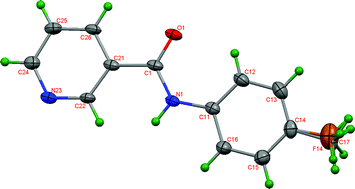 In this HOT article, scientists from Dublin, Ireland have directed their research towards integrating crystal structure analyses with computational (ab initio) modelling methods and exploring the influence and positional influence of different functional groups e.g. N/F/Cl/Br/I atoms, Me/OMe in semi-rigid drug-like molecules on inter- and intramolecular interactions, conformations and solid-state packing.
In this HOT article, scientists from Dublin, Ireland have directed their research towards integrating crystal structure analyses with computational (ab initio) modelling methods and exploring the influence and positional influence of different functional groups e.g. N/F/Cl/Br/I atoms, Me/OMe in semi-rigid drug-like molecules on inter- and intramolecular interactions, conformations and solid-state packing.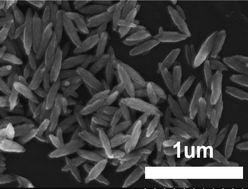 composed of nanoparticles) composed of nanoparticles under hydrothermal conditions. Ethylene glycol was used as the solvent which can decrease the reaction rate by forming ligand bonds with lanthanide ions and further control the final morphology of the product. Eu3+ ion was chosen as a structural information probe to obtain more luminescent and phase structure information.
composed of nanoparticles) composed of nanoparticles under hydrothermal conditions. Ethylene glycol was used as the solvent which can decrease the reaction rate by forming ligand bonds with lanthanide ions and further control the final morphology of the product. Eu3+ ion was chosen as a structural information probe to obtain more luminescent and phase structure information.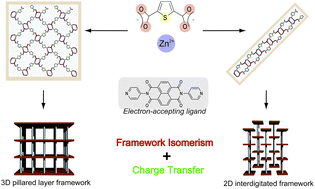 In this HOT article, Kitagawa and co-workers describe two isomorphic frameworks, [Zn(thdc)(dpNDI)]n, based on 2,5-thiophenedicarboxylate (thdc) as the topology-directing ligand, assembled from zinc ions and N,N‘-di(4-pyridyl)-1,4,5,8-naphthalenediimide (dpNDI) as the electron-accepting ligand. The unique connecting angle of thdc promotes the formation of either a 3D pillared-layer framework or an interdigitated 2D layer framework, which are originally synthesized with terephthalic acid or isophthalic acid, respectively. In addition, these isomers show different charge-transfer interactions with electron-donating aromatic molecules because of their intrinsic porous structure determined by their topology. Such a topological design of PCPs can be used in guest-selective sensor materials.
In this HOT article, Kitagawa and co-workers describe two isomorphic frameworks, [Zn(thdc)(dpNDI)]n, based on 2,5-thiophenedicarboxylate (thdc) as the topology-directing ligand, assembled from zinc ions and N,N‘-di(4-pyridyl)-1,4,5,8-naphthalenediimide (dpNDI) as the electron-accepting ligand. The unique connecting angle of thdc promotes the formation of either a 3D pillared-layer framework or an interdigitated 2D layer framework, which are originally synthesized with terephthalic acid or isophthalic acid, respectively. In addition, these isomers show different charge-transfer interactions with electron-donating aromatic molecules because of their intrinsic porous structure determined by their topology. Such a topological design of PCPs can be used in guest-selective sensor materials.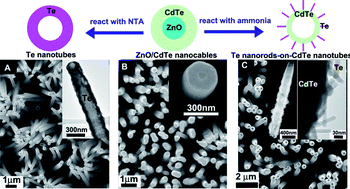 elated arrays have been achieved on ITO by a ZnO nanorod templating-reaction method under different etching conditions.
elated arrays have been achieved on ITO by a ZnO nanorod templating-reaction method under different etching conditions.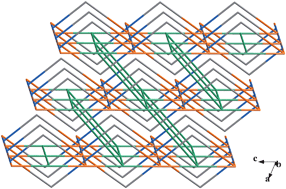 A novel POM-based 3D self-penetrating MOF containing Mo–N covalent bond has been isolated under hydrothermal conditions, showing an unprecedented (4,6,6)-connected topology assembled from a 2D self-threading skeleton.
A novel POM-based 3D self-penetrating MOF containing Mo–N covalent bond has been isolated under hydrothermal conditions, showing an unprecedented (4,6,6)-connected topology assembled from a 2D self-threading skeleton.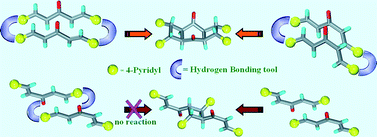 A double [2 + 2] photochemical reaction of 1,5-bis(4-pyridyl)-1,4-pentadiene-3-one (1P) was observed with in four co-crystal forms of 1P with the hydrogen bonding template molecule phloroglucinol (PG) or 5-methoxy resorcinol (MR). 1H NMR and the UV-vis spectroscopic studies established a stepwise mechanism for this reaction through the formation of a monocyclobutane intermediate.
A double [2 + 2] photochemical reaction of 1,5-bis(4-pyridyl)-1,4-pentadiene-3-one (1P) was observed with in four co-crystal forms of 1P with the hydrogen bonding template molecule phloroglucinol (PG) or 5-methoxy resorcinol (MR). 1H NMR and the UV-vis spectroscopic studies established a stepwise mechanism for this reaction through the formation of a monocyclobutane intermediate.